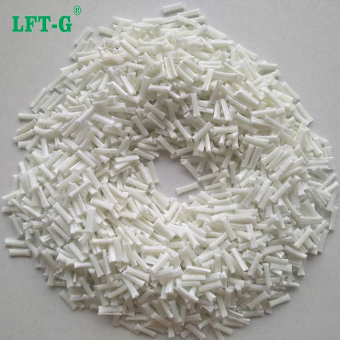-
Industrial new material PPA composite long carbon fiber higher performance lower priceWhat is PPA? PPA (Polyphthalamide) is polyphthalamide. PPA is a kind of thermoplastic functional nylon with both semi-crystalline structure and non-crystalline structure. It is prepared by polycondensation of phthalic acid and phthalenediamine. It has excellent thermal, electrical, physical and chemical resistance and other comprehensive properties. It still has excellent mechanical properties, including high rigidity, high strength, high dimensional accuracy, low warping and stability, fatigue resistance and creep resistance, under the harsh working environment of continuous high temperature, humidity, oil pollution and chemical corrosion at 200℃. The main application is non-crystalline PPA. PPA has high hardness, excellent mechanical strength such as bending, tensile and impact at high temperature, and can resist tensile creep for a long time. Its rigidity and strength even exceed PPS and PEEK at the high temperature of 120℃. Especially suitable to replace die casting alloy to reduce cost. PPA has higher thermal stability than PA46, better arc resistance and infrared reflow welding ability of CTI. PPA has excellent resistance to gasoline, diesel, oil, mineral oil, transformer oil and other oils, even at high temperature of 150℃. PPA is suitable for long-term outdoor use without reducing physical properties even in extreme climate conditions such as high UV radiation, high humidity and high temperature. PPA resin is stronger and harder than fatty polyamides such as nylon 66; Less sensitive to water; Better thermal performance; And much better creep, fatigue and chemical resistance. The vast majority of PPA resins are processed by traditional injection molding. What is Long carbon fiber? Long carbon fiber reinforced composites offer significant weight savings and provide optimum strength and stiffness properties in reinforced thermoplastics. The excellent mechanical properties of long carbon fiber reinforced company make it an ideal replacement for metals. Combined with the design and manufacturing advantages of injection molded thermoplastics, long carbon fiber composites simplify the re-imagining of components and equipment with demanding performance requirements. Its widespread use in aerospace and other advanced industries makes it a "high-tech" perception of consumers - you can use it to market products and create differentiation from competitors. What is the application of PPA-LCF? Suitable for high temperature, anti-static, high-strength components. Other products can also ask for our advice. We have 24h 1V1 service for you. Xiamen LFT composite plastic Co., ltd Xiamen LFT composite plastic Co., Ltd. is a brand-name company that focuses on LFT&LFRT. Long Glass Fiber Series (LGF) & Long Carbon Fiber Series (LCF). The company's thermoplastic LFT can be used for LFT-G injection molding and extrusion, and can also be used for LFT-D molding. It can be produced according to customer requirements: 5~25mm length. The company's long-fiber continuous infiltration reinforced thermoplastics have passed ISO9001&16949 system certification, and the products have obtained lots of national trademarks and patents. In particular, the carbon fiber LFT series produced by our company has broken the technical blockade of foreign countries. For domestic: automotive, military parts, firearms, aerospace, new energy, sports equipment and other fileds require high-performance thermoplastic special engineering plastics. And other new technology innovation industries provide product and technical support.
- polyphthalamide
- PPA-LCF
- General grade material
- High strength composite
- Plastic PPA
- Original color
Tags :
-
Xiamen LFT-G PPS Polyphenylene sulfide composite long glass fiber thermoplastic original colorPPS information The resin matrix of thermoplastic composites involves general and special engineering plastics, and PPS is a typical representative of special engineering plastics, commonly known as "plastic gold". Performance advantages include the following aspects: excellent heat resistance, good mechanical properties, corrosion resistance, self-flame retardant up to UL94 V-0 level. Because PPS has the advantages of the above properties, and compared with other high performance thermoplastic engineering plastics and has the characteristics of easy processing, low cost, so it becomes an excellent resin matrix for manufacturing composite materials. PPS composite material PPS filling short glass fiber (SGF) composite material has the advantages of high strength, high heat resistance, flame retardant, easy processing, low cost, and has been applied in automotive, electronics, electrical, machinery, instruments, aviation, aerospace, military and other fields. PPS filling long glass fiber (LGF) composite material has the advantages of high toughness, low warpage, fatigue resistance, good product appearance and so on. It can be used in water heater impeller, pump shell, joint, valve, chemical pump impeller and shell, cooling water impeller and shell, household appliance parts and so on. What are the specific differences between short glass fiber (SGF) and long glass fiber (LGF) reinforced PPS composites? 1. Mechanical property analysis The reinforcement fiber added in the resin matrix can form a supporting skeleton, and the reinforcement fiber can effectively bear the external load when the composite is subjected to external force. At the same time, energy can be absorbed by fracture, deformation and other ways to improve the mechanical properties of resin. The tensile strength and bending strength of the composites are gradually increased by increasing the amount of glass fiber. The main reason is that when the glass fiber content increases, more glass fiber in the composite material can withstand the action of external force. Meanwhile, due to the increase in the number of glass fibers, the resin matrix between the glass fibers becomes thinner, which is more conducive to the construction of glass fiber reinforced frame. Therefore, with the increase of glass fiber content, more stress is transferred from resin to glass fiber under external load, which effectively improves the tensile and bending properties of composite materials. The tensile and bending properties of PPS/LGF composites are higher than those of PPS/SGF composites. When the glass fiber mass fraction is 30%, the tensile strength of PPS/SGF and PPS/LGF composites is 110MPa and 122MPa, respectively. The bending strength was 175MPa and 208MPa, respectively. The flexural elastic modulus were 8GPa and 9GPa, respectively. The tensile strength, bending strength and bending elastic modulus of PPS/LGF composites are increased by 11.0%, 18.9% and 11.3% compared with PPS/SGF composites, respectively. PPS/LGF composites have higher length retention rate of glass fiber. Under the condition of the same glass fiber content, the composites have stronger load resistance and better mechanical properties. When the glass fiber content is low, the impact strength of the composite decreases. The main reason is that the lower glass fiber content cannot form a good stress transfer network in the composite material, so that the glass fiber exists in the form of defects under the impact load of the composite material, resulting in the overall impact strength of the composite material is reduced. With the increase of the glass fiber content, the glass fiber in the composite can form an effective spatial network, and the reinforcement effect is greater than that of the glass fiber tip. Under the action of external load, the external load can be transferred to the reinforced fiber better, thus improving the overall performance of the composite. In the PPS/LGF system, the length of the glass fiber is longer and the spatial network is more dense. The reinforced glass fiber has greater bearing capacity and better impact strength. When the mass fraction of glass fiber is 30%, the impact strength of PPS/LGF is increased by 19.4% from 31kJ/m2 to 37kJ/m2, and the notch impact strength is increased by 54.5%(from 7.7kJ/m2 to 11.9kJ/m2). 2. Thermal properties analysis of PPS/SGF and PPS/LGF composites When the mass fraction of glass fiber is 30%, the thermal deformation temperature of PPS/SGF composite and PPS/LGF composite reaches 250℃ and 275℃, respectively. The thermal deformation temperature of PPS/LGF composite is 10% higher than that of PPS/SGF composite. The main reason is that the introduction of glass fiber makes the network skeleton of reinforced fiber formed inside the composite material, which greatly improves the heat resistance of the composite material. The size of glass fiber in PPS/LGF is longer, and the heat resistance improvement advantage is more obvious....
- New high performance thermoplastic resin
- A crystalline polymer reinforced plastic pps
- Long glass fiber filling plastic
- Customized material PPS self factory made
- Industrial raw material thermoplastic ppa
- High impact resistance lgf
Tags :

 e-mail
e-mail English
English français
français Deutsch
Deutsch русский
русский italiano
italiano español
español português
português العربية
العربية 日本語
日本語 한국의
한국의 中文
中文














